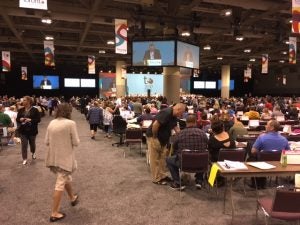Did you know that all unionized members are voting as one block for the pension merger. If you want your voice heard, it is not too late. There will be a second day of voting on November 9th with voting times from 12-2pm and 7-9pm. If you are on shift during both of these times slots, we encourage you to speak to your Coordinator. Voting takes place at the Ottawa CUPE Regional Office at 1378 Triole Street (next to the CUPE National office, just make your way to the back of the parking lot).
CUPE National Convention 2017
CUPE 2195 Supports Overdose Prevention Ottawa
On September 6th 2017 at their general membership meeting the members of CUPE 2195 proudly voted to support Overdose Prevention Ottawa by promoting their work and fundraising efforts, via our networks. CUPE 2195 Also voted to send the following letter to our elected officials. If you have a minute please take a look at the above links and support by sharing the information or donating is you are able.
Sept 6th, 2017
We, CUPE Local 2195 (workers of the Youth Services Bureau of Ottawa) are writing you today to voice our deep support for Overdose Prevention Ottawa’s efforts to address the overdose crisis in our city. We ask that you support Overdose Prevention Ottawa’s health measures and ensure the site can continue to operate without efforts to close it by law enforcement.
Overdose prevention sites are a harm reduction-based health service that provides people with an immediate health intervention to prevent a fatality from overdose. This harm reduction measure is proven to work to reduce the number of preventable fatalities from overdose. In
Vancouver alone, 147,705 visits, and 770 overdoses were reversed. Every day, frontline workers and community members witness the rising numbers of preventable overdoses. In 2015, more than two people died of overdose in Ontario every day. In Ottawa, the rate of death from overdose increased 32% between 2014 and 2015. Recently, Ottawa Public Health released data on emergency department visits for drug overdoses.
These public health statistics on overdoses are only the tip of the iceberg. This data considers only a portion of the overdoses experienced by people who use drugs in our city since the vast majority will not call emergency services due to fear of criminalization, stigma, and interactions with the police. Even the Federal Health Minister, Jane Philpott, acknowledges that nationally we have insufaicient data on overdose deaths.
We are proud of Overdose Prevention Ottawa for taking steps to bring this necessary harm reduction service to Ottawa. The City of Ottawa must support Overdose Prevention Ottawa and take a step to address the overdose crisis our city is facing.
Sincerely,
Members of CUPE Local 2195
(Workers of the Youth Services Bureau of Ottawa)




